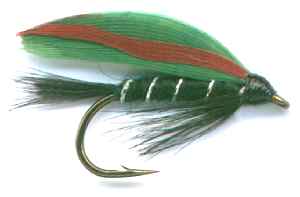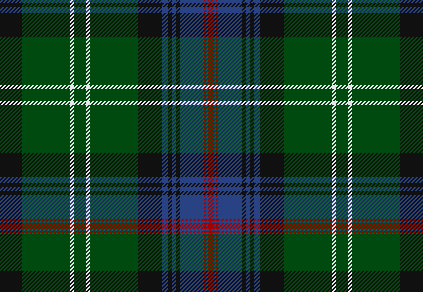TAR12. The Scottish Clan Sutherland
Single Hook Tartan Fly











TARTAN FLY PATTERNS OF SCOTLAND. Hook size 8 - $US each
Unlike most dry flies and nymphs, lure (streamer) flies do not try to represent a natural insect or bait fish. They are attractor flies that try to give the appearance of some thing that a trout may consider edible. I have found them successful when the fish do not seem to be taking an interest in their normal food. The appearance of this exotic looking fly seems to provoke a reflex attack reaction in some trout. This is particularly so if you can make you fly invade their 'space' as they are very territorial.









CLAN SUTHERLAND
Motto: Without fear
Main Colors: green, red, black and
white
The clan took their name from the word used by the Vikings for an area now a county, that lies south of Caithness. The original population of the district were driven out or destroyed by the Norwegians when they took possession of the country. After its conquest by Thorfinn, the Norse Jarl of Orkney, in 1034,Norse settlers moved in. The Earldom of Sutherland is claimed to be the oldest. It was granted by King Alexander II, to William, Lord of Sutherland, about 1228, for assisting to quell a powerful northern savage of the name of Gillespie. William was the son of Hugh Freskin, who acquired the district of Sutherland by the forfeiture of the Earl of Caithness for rebellion in 1197. Hugh was the grandson of Freskin the Fleming, who came into Scotland in the reign of David I, and obtained from that Prince the lands of Strathbrock in Linlithgowshire, also, the land of Duffus and others in Moray.
His son, William the 2nd Earl, was a constant attendant on King William the Lion. He was one of the Scots nobles who attended the parliament of Alexander III at Scone, 5th February 1284, when the succession to the crown of Scotland was settled, and he sat in the great convention at Bingham, 12th March 1290. He was one of the eighteen Highland chiefs who fought along side of Robert the Bruce at the battle of Bannockburn against the English. He died in 1325, having enjoyed the title for the long period of 77 years. The 3rd Earl was killed at the battle of Halidon Hill, supporting the cause of king David II but the 4th Earl of Sutherland married Robert the Bruce's daughter.
In 1567 the eleventh Earl and his wife were poisoned by Isobel Sinclair, the wife of the earl's uncle, Golbert Gordon of Gartay, and the cousin of the Earl of Caithness, they died five days afterwards The clan continually feuded with neighbouring clans throughout the centuries. In 1637, John, fourteenth Earl of Sutherland, joined the supplicants Against the service book, and on the breaking out of the civil war in the following year joined the parliamentary cause against King Charles I. In 1641 he was appointed by parliament a privy councillor for life, and in 1644 he was sent north with a commission for disarming royalists. In 1645 he was one of The committee of estates. The same year he joined General Hurry, with his Retainers at Inverness, just immediately before the battle of Auldearn. In 1650 he accompanied General David Leslie when he was sent by the parliament against The royalists in the north. On the Marquis of Montrose's arrival in Caithness, the earl assembled all his countrymen to oppose his advance into Sutherland. Montrose, however, had secured the important pass of the Ord, and on his entering Sutherland, the Earl, not conceiving himself strong enough to resist him, retired with about 300 men into Ross. In August of the same year, the Earl set off to Edinburgh, with 1000 men, to join the forces under General Leslie, collected to oppose Cromwell, but was too late for the battle of Dunbar, which was fought before his arrival. During the Protectorate of Cromwell the Earl lived retired.
The clan Sutherland could bring into the field 2,000 fighting men. During 1715 and 1745 Risings, the Sutherlands supported the Hanoverian cause, their estimated fighting strength was 2,000 men, many of whom were later enlisted in the Sutherland Fencibles, raised in 1759. In 1833, the Duke's ill-conceived 'improvements' on his estate caused much misery and led to excessive clearance evictions which took almost the whole population of his lands overseas.







Tartan in Scotland
For many centuries tartan was the everyday dress of highland Scotland.
Although
it was worn in other parts of Scotland it was in the Scottish Highlands that
it
continued to be developed into a symbol of belonging to a particular clan. A
clan is like a tribe. Different areas of Scotland were controlled by
different
families.
Tartans used several centuries ago were very simple checks of two or three colours. These colours were obtained by using the dye from roots, plants, berries and trees.
When chemical dyes were invented a broader range of colours became available. More elaborate patterns were woven and branches of larger clans developed tartans of their own by adding an extra stripe or other variation of the main clan tartan pattern.
In the Royal Treasurer's accounts of 1471 there is a the first reference to the King of Scotland, James III, purchasing tartan. King James V wore tartan when out hunting in the Highlands in 1538. When Queen Elizabeth I of England died childless the Scottish King James VI of the Royal clan Stuart became King James I of England as well as Scotland. The English and Scottish King Charles II wore clan Stuart tartan ribbons on his coat at his marriage in 1662. In 1587 one of the first references to clan tartans was found in crown documents that show Hector MacLean of Duart paid the duties owed on his land not with money but with sixty bales of cloth of white, black and green. These colors are the colors of the MacLean hunting tartan.
Some Historians suggest that prior to the 18th century clansmen wore whatever pattern the weavers chose to supply, but in a recorded court case in 1572 a housewife won her case against a weaver who failed to supply her with the tartan cloth of the correct design. There are a number of literary references in the early 1700's to clansmen dressed in the livery of their chiefs. It is known that clans were organised on military lines, and that there were clan regiments. The tartan livery was the regimental uniform.
In 1688 the Stuart King James II was forced from the British throne because he was wanted to give greater freedoms to Catholic's. He was the first openly Catholic King since Henry VIII. In 1714 when the crown was offered to the Hanovarian King George I many people in Scotland were unhappy having a foreign ruler. They wanted a Stuart King on the British throne. Their hopes lay in the son of King James II, called James Stuart. His supporters were called 'Jacobites'. In 1715 the rebellion was easily put down and James fled to France. A greater threat to the British throne appeared in 1745. This invasion was lead by James Stuart's son, Charles Stuart, known as Bonnie Prince Charlie. With help from the French he landed on the Outer Hebrides. He then sailed to the Scotish mainland and marched southwards with a growing number of Higland clans. His followers were again called Jacobites. They captured Edinburgh and crossed into England. Few English joined the Jacobites. King George II sent a large army to oppose them. Bonnie Prince Charlie retreated to Scotland. In April 1746 the two armys meet at Culloden. The rebels lost and Bonnie Prince Charlie escaped to France. He had no children and he was the last Stuart to fight for the British throne. Because of the support of the Higland clans the British Government passed laws to stop any more Jacobite risings. These laws tried to destroy the clan system.









After the English victory at the battle of Culloden the London Government, in an attempt to purge the Highlands of all rebellious elements, passed an Act of Parliament disarming all Highlanders and made it unlawful to wear tartan. This was rigorously enforced and thus suggests that the clan tartan was worn with pride and as a sign of loyalty to their chief and the Stuart claim to the British throne rather than the German King Georges.
The act was repealed in 1785, but by that time the Highlanders had become accustomed to wearing other dress. Many of the tartan weavers had died taking details of the old styles with them to the grave. The first tartan revival occurred in 1822 when King George VI, whilst visiting Edinburgh, gave instructions that he desired local dignitaries to wear their clan tartan to royal functions. This resulted in new tartans being invented since those who had no clan tartan found tailors who could invent one for them.
Tartans are described by the purpose for which they are used
Clan Tartans: These are patterns for general use by members of the clan.
Dress Tartans: These were originally worn by the women of the clan and were lighter coloured variations of the clan tartan pattern.
Hunting Tartans: These were worn for sport. If a clan's tartan was brightly colored then their hunting tartan was designed using normally browns and greens so the wearer was less visible against the heather, grass and bracken of the moors and mountains.
Mourning Tartans: Dark variations on the clan tartan for use at funerals and during periods of mourning.
Chief's Tartans: These are special designs that are only worn by the clan chief and his immediate family.
Royal Tartans: These should never be worn by anyone outside the Royal family
















To be sent regular information on flyfishing flies and news on special offers just click the British Royal Mail Post box
You can e-mail us at fly.fishing@blueyonder.co.uk
The English Fly Fishing Shop, Estate and Country Sports Equipment Ltd,
5 Woodland Way, Morden, Surrey SM4 4DS, England (Established 1978)